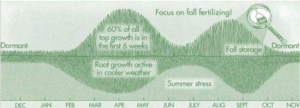Fertilizing
New research shows that lawns need less fertilizing.
Follow these tips to get great results at a lower cost to you and our environment.
Do a soil test
- You don’t know what your lawn needs without one!
Fertilizer basics
- Unless you have a soil test that identifies a need for phosphorus and potassium, all you need is nitrogen. Look for 10-0-0 on the bag (cornmeal gluten is a good choice).
- For free fertilizer, always return the clippings to your lawn.
- If an unfertilized lawn is acceptable, then don’t fertilize!
Older lawns – 10+ yrs old
- Lawns older than 10 years need only clippings.
- If fertilization is deemed necessary, start with 1/3 of the amount recommended on the bag label, monitor the lawn, and apply more only if the lawn needs it. Don’t apply more than 2 pounds of nitrogen per 1000 square feet.
New lawns – under 10 years old
- Younger lawns need nitrogen.
- Start with 1/3 of the amount recommended on the bag, monitor the lawn, and apply more only if the lawn needs it up to a total of 2 pounds per 1000 square feet.
When should I fertilize?
- The best time to fertilize is between August 15th and September 15th.
- Grass needs to be growing to take up fertilizer.
Use slow-release organic fertilizer
- Improves soil health and fertility.
- Slowly releases nutrients so they feed your lawn, not our streams, rivers, and groundwater.
- Most come from sustainable, renewable resources.
- Look for corn meal gluten, a byproduct from milling corn. It’s a great source of Nitrogen for your lawn!
Notes on synthetic fertilizers
- Derived from natural gas, a nonrenewable resource.
- Many contain soluble nitrogen that can wash into rivers and streams, wasting your time and money.
- If you do use synthetic fertilizer, look for slow-release nitrogen. Using slow-release nitrogen helps ensure that your lawn’s root system takes in the nutrients before they wash away.
Other tips
- Try compost tea!
- Choose grasses such as fescues that require less nutrient and water inputs.
- Check out our Overseeding & Compost Tea fact sheets!

Credit: Cumberland County Soil & Water Conservation District.
Learn more at: http://cumberlandswcd.org/site/yardscape-2/

